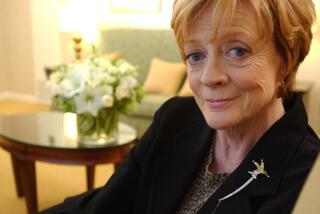ART REVIEW : A Collage Education : MOCA Survey Traces Development of Alexis Smith’s Career
In 1975, Alexis Smith made a collage out of macaroni--specifically, out of macaroni letters like the ones in a can of alphabet soup. Glued in a single line across a plain, 12x9-inch sheet of heavy white paper, they portentously announced: “Words cannot cook rice--Charlie Chan.”
A number of rather profound differences could be cited between this odd little collage and the loftier pursuits of art--especially the aesthetically daring pursuits of Conceptual art so central to the period in which her collage was made. Among the most notable are its materials and its subject. A macaroni collage? Quoting B-movie philosophy ? You and I could do that ourselves.
Which is, of course, very much the point. Alexis Smith’s art is contentedly made from the stuff of modern convention. It’s her raw material, with which she builds bridges to other realms. On one hand, thanks to Picasso, nothing could be more redolent of 20th-Century High Art than collage. On the other, who among Smith’s generation didn’t do the macaroni version in the third grade?
“Alexis Smith,” the 20-year, midcareer survey of the Los Angeles-based artist’s work that opened Sunday at the Museum of Contemporary Art, does a superlative job of tracking the complicated terrain from which this art emerged, without ever losing its focus on the specific trajectory of Smith’s work. Curator Richard Armstrong of New York’s Whitney Museum of American Art, where the show had its debut in November, has chosen the survey well, and its catalogue is a model of clarity. Even if you’ve closely followed the development of Smith’s mature work during the past dozen years, the exhibition will answer lots of questions.
It’s also magnificently installed. The big pyramid gallery at the entry opens with an expansive, 1981 installation mixing murals and collages, and based on the play and opera “Porgy and Bess.” (During the run of the show, a grand piano in a corner will be periodically played. You might wish to dance to the Gershwin music.)
Next, the small pyramid gallery presents “Past Lives,” an evocative 1989 installation collaboratively produced with poet Amy Gerstler. The gallery also includes two early collages from the 1970s, including the “macaroni masterpiece.” Smith is turning out to be among our most important public artists, and her development of a particular kind of installation work in the 1980s, with its sources in collage, is deftly announced in these first two rooms.
The remainder of the show is installed in MOCA’s south gallery--the big, devouring, gymnasiumlike space that has chewed up and spit out most every show installed there before. Five more collaged-mural installations are included, along with numerous examples of early work and full complements of the three thematic series of collages Smith made in the 1980s. The gallery looks first-rate.
The attention to presentation and display is important, because it represents the hurdle Smith herself overcame in finding a workable means for making her art. The earliest object in the show is “Colorado” (1971), a loose-leaf book with collage pages. Soon, this book-format got flattened out, its pages disassembled and lined up, one after the other, in a horizontal row encased in a Plexiglas frame. It never felt quite right, although Smith perceptively played with the form--the horizontal expanse becoming a roadway littered with expository trash, or a city skyline harboring bits of unfinished stories. But the format remained awkwardly suspended between the private world of a book, read by one person at a time, and the public world of the gallery wall, to which it aspired.
“Hello Hollywood” (1980) was the breakthrough piece. While retaining popular literary narrative and collage, Smith here discarded the book motif. She turned instead to a pre-existing, verbal-visual form: those Burma-Shave signs once ubiquitous along roadside America.
Smith paired simple objects--a strip of celluloid, a postcard, a red-checked bow, a party-favor horseshoe--with an actual poem from the advertising series, and she put the collages in frames tilted forward, like a cartoon imitation of drive-by movement. Silhouettes of receding palm trees or telephone poles (it’s been installed in different ways at different times) are painted on the walls, and a bale of hay completes the ensemble.
“Hello, Hollywood/Goodby, Farm/It Gave McDonald/That Needed Charm/Burma-Shave.” Recontextualized, content fuses with form. A cornball Burma-Shave poem is opened up to reveal a queer narrative of Modernist transformation, which records (and cheers on) the passage of an agrarian culture and the arrival of a phantasmagorical urban world, predicated on image consumption. You’re invited to consider this rather heady revolution from your perch atop a hay bale--a slyly funny, rural riff on the contemporary sculptural convention of the Minimalist box.
Smith’s not simply a popularizer of arcane avant-gardism. Instead, her commitment to collaging together visual and verbal languages--movies, romance novels, magazines, advertising and such--claims a more surreptitious aim. Using pop culture as her model, she’s the artist as seductress--Scherherezade the Storyteller, as the title of a 1976 performance piece plainly declared. Smith wants to get under your skin and take you for an imaginative ride.
Her attachment to the myriad “debased” forms that exist outside the mainstream of artistic culture makes many people inside that mainstream nervous. But, it points to something significant, to the inescapable ordinariness of art in a post-industrial world. As Los Angeles has always existed outside the High Culture mainstream, standing as a global symbol of modern cultural debasement, it’s easy to see why Smith’s art probably couldn’t have been made in another place--and why it has the capacity to speak to just about anyone, anywhere.
The retrospective chronicles the development of two principal tributaries in Smith’s work. While related, each has its own distinct qualities.
One is the explosion of collage to environmental scale, transforming with order and insight the vague and chaotic experience of our contemporary image-glut. This is the source of her significance as a public artist.
Although a colossal installation such as “The Grand”--the remarkable 1982 renovation of a three-story lobby in a Grand Rapids, Mich., performing arts center--can only be included here in catalogue photographs, the seven installations that are on view show her range and command. It culminates with the extraordinary “Same Old Paradise,” a 1987 CinemaScope-mural-with-collage, for which a permanent home (preferably in this city) ought to be found straightaway.
The other tributary is the elevation of collage to the traditional stature of painting, an equation Smith creates by embracing, rather than rejecting, painting’s myriad historical conventions. Still life, portrait, landscape, history painting, allegory, religious narrative--it’s hard to think of a single genre Smith has ignored. Perhaps the clearest sign of her approach is her enthusiastic revival of the picture frame, banished from most “serious” postwar painting. For Smith, the decorative frame is integral to the collage.
These dual tributaries share important features. To the Modernist conception of art as an arena for self-invention and re-creation, Smith has added an insistence on art considered in its broadest sense. And, her conception of selfhood is not essentialist; instead, the self is an endlessly variable fabrication glued together from scavenged parts. Hence her anointment of collage as a major medium.
Smith’s 1975 macaroni collage-cum-homage to Charlie Chan always manages to remind me of a famous, 1969 statement by artist Sol Lewitt. “Conceptual artists are mystics rather than rationalists,” Lewitt wrote, in an influential manifesto published while Smith was still an art student. “They leap to conclusions that logic cannot reach.” The exhibition demonstrates it’s a sentiment with which Smith’s work passionately agrees--and, simultaneously, with which it takes pointed issue. She knows that words can do a lot, but they can’t cook rice.
* At the Museum of Contemporary Art, 250 S. Grand Ave., (213) 621-2766, through July 5. Closed Monday.
More to Read
The biggest entertainment stories
Get our big stories about Hollywood, film, television, music, arts, culture and more right in your inbox as soon as they publish.
You may occasionally receive promotional content from the Los Angeles Times.











